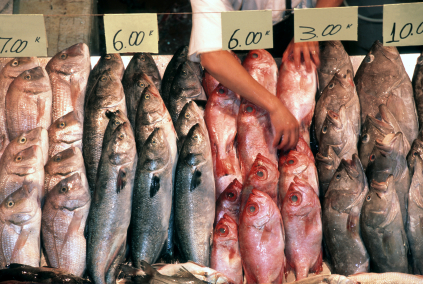
This has to be annoying to nearly everyone. You’re trying to do the right thing by eating more fish. You may not cook it at home, but at least you’re eating it out more often, getting those heart-healthy omega-3 fats and all. It’s good that you’re making a conscious effort, albeit one that’s harder on your wallet, because there’s a real cost to ordering the fish instead of the chicken.
Then a story comes out in the New York Times last week (the second one on the topic in two months) that makes you feel like a fool: a nationwide study by the nonprofit ocean-protection group Oceana finds that a third of all seafood may be mislabeled. And that’s the average. The study, which used DNA testing from 1,215 samples around the country, found that red snapper was mislabeled 87 percent of the time and tuna 59 percent of the time—often with cheaper substitutes. And as the Times pointed out in a December 2012 story on the study, 94 percent of so-called tuna was not tuna at all, but in many cases a fish called “snake mackerel,” or “escolar,” which contains a toxin that can cause severe diarrhea if you eat more than a few ounces.
The study suggests that depending on what you order, chances are high that you’re getting a knock-off version of the type of seafood you ordered—or even (gasp) being served seafood that you were really trying to avoid for health reasons.
That bites.
Worse, sometimes it’s not just about eating cheaper fish (and paying the higher price) but eating a fish your conscience normally wouldn’t allow you to eat because it’s being depleted in the ocean. And most troubling of all, the study also found that fish such as tilefish, which is high in mercury—best avoided by children and pregnant women—was found to be substituted for red snapper.
Chefs aren’t immune to this problem of mislabeled fish. There are often subtle differences among species of fish that can challenge even supposed experts.
This kind of mislabeling may be happening at the restaurant level, but restaurants are also being duped. It’s often hard to know who is to blame; the supply chain for fish can be long and convoluted because fish is an increasingly global commodity.
Increased demand for fish on restaurant menus probably makes it even more tempting for fishers or purveyors to pass off cheaper or less desirable varieties as premium ones, rather than letting them “go to waste” by discarding them or tossing them back into the ocean.
Here are a few tips to improve your chances of getting what you’re paying for as a consumer:
Tuna and red snapper are the most likely to be mislabeled. There are plenty of fish in the sea, so step away from the familiar swimmers and try another variety, either at home or when eating out. You can likely prepare them the same way with great results.
- If you happen to see inexpensive and nutritious tilapia on a menu, grab it. It’s not likely the restaurant will be substituting a more expensive fish for it.
- Go national for your fish. Big chain supermarkets are less likely to have mislabeled fish than are the smaller, independent shops.
- Go for fish with a distinct appearance. Salmon comes to mind. Your main concern there is paying for farmed salmon when you think you’re getting wild. It’s almost impossible to tell the difference, but at least both are nutritious. You’re more likely to be getting what you ordered with distinctive-looking fish.
Still, the reality is unsettling. As Oceana points out, the U.S. imports more than 90 percent of the seafood it consumes, but the FDA inspects less than 1 percent for fraud.
That leaves consumers paddling upstream.


Comments on this entry are closed.
Keith,
This is both eye-opening and helpful information. Thanks! Is there a website or listing of other fish that folks might look for besides tilapia and salmon? I think of flounder, sole and sardines (the latter recommended for calcium). Do you have any resources you can recommend?
Karen,
Here’s what Keith had to say:
“Here are two that I’d suggest, the Monterey Bay Aquarium is heavy into this, both for safety and eco-friendliness. The latter focuses on protecting endangered species and also environmentally friendly fish. Of course, nothing really protects against mislabeling. Sardines however, are on everyone’s safe list and are eco-friendly and still really healthy. Huge source of omega-3s and calcium. They’re almost the gold standard.”
https://www.montereybayaquarium.org/cr/seafoodwatch.aspx
https://apps.edf.org/page.cfm?tagID=1521
Hello, regarding farmed salmon, you should do some more research on that matter. Doctors are recommending avoiding eating farmed salmon more than once every three months and not at all for children and expectant/ nursing mothers. It doesnt have the omega 3’s of wild caught, nor does it taste the same. Its being sold with a desease called infectious salmon anemia, or isa equivelent to swine flu, it will kill the fish eventually. And dont forget all those yummy tumours. If you have a concience about eating sustainable, then farmed salmon arent for you, the meal they are being fed is partially made from other wild stocks, and where they are harvesting these wild stocks a crash in the food chain is a result, just ask them down in Chile!